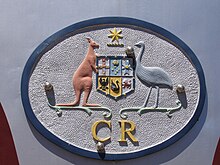Commonwealth Railways
The Commonwealth Railways were a railway company owned by the Australian Confederation .
founding
In 1901 the six previously autonomous Australian colonies merged to form the state of Australia. The condition for the accession of the relatively isolated state of Western Australia was the promise that the federal government would build a railway that would connect the settlement center of the colony around its capital Perth with the other settlement centers of the new state in the south and east of the continent.
In 1911 the law on the construction of the Trans-Australian Railroad was passed and - in order to be able to implement it - in 1912 the Commonwealth Railways were founded for its construction and subsequent operation .
Infrastructure
The Trans-Australian Railway between Port Augusta and Kalgoorlie started operating in 1917. It was built in standard gauge and was therefore an island operation between the Western Australia Railway and the Great Northern Railway , both in Cape Gauge at that time . For this reason, the line was extended to Port Pirie in 1937 , where there was a direct connection to the 1600 mm network of the South Australian Railroad and thus no transfer or reloading was required.
The initial inventory of Commonwealth Railways also included the Cape Gauge Railway between Port Augusta and (at that time) Oodnadatta , known as the Great Northern Railway , whose railway infrastructure was taken over by the railway from South Australia. It was in central Australian Railway - renamed but operated until 1926 by train from South Australia (Australia Central Railway CAR). The Commonwealth Railways extended it to Alice Springs in 1929 .
In 1914, the Commonwealth Railways opened the Australian Capital Territory Railway , a railway line only eight kilometers long, which connected the Australian capital Canberra , a federal territory , in the same gauge to the standard-gauge network of the neighboring railway in New South Wales . Only the railway infrastructure belonged to the Commonwealth Railways , the operation was always carried out by the railway of New South Wales.
1918 took over Commonwealth Railways , the North Australia Railway from the management of the Northern Territory , which also was under the federal government. The railway was extended to Birdum until 1929 .
In 1957, the section of the Great Northern Railway between Port Augusta and Marree was replaced by a new standard gauge line. The reason was the substantial coal transports from Leight Creek and the topographically unfavorable route of the historic route.
In 1968 the track of the Trans-Australian Railroad between Kalgoorlie and Perth was provided with a third rail for the standard gauge.
In 1970 the standard gauge track between Port Pirie and Broken Hill was put into operation. This made the transcontinental connection Perth - Sydney passable for the first time, and the Indian Pacific began operating as a "parade train" of the Commonwealth Railways.
In 1975 the Commonwealth Railways were transferred to the newly founded Australian National .
traffic
The Commonwealth Railways were an integrated rail infrastructure and rail transport company . Their most famous offers were
- Tea and Sugar , since 1913 (supply train for employees and residents along the Trans-Australian Railway)
- Trans-Australian , since 1917 (retired 1991)
- The Ghan , acquired by the South Australian Railways in 1926
- Indian Pacific , since 1970
In addition, other connections and especially freight traffic were operated.
literature
- CH Henshaw: Overland to Perth in 1928 . In: Australian Railway Historical Society Bulletin, April, 1964.

